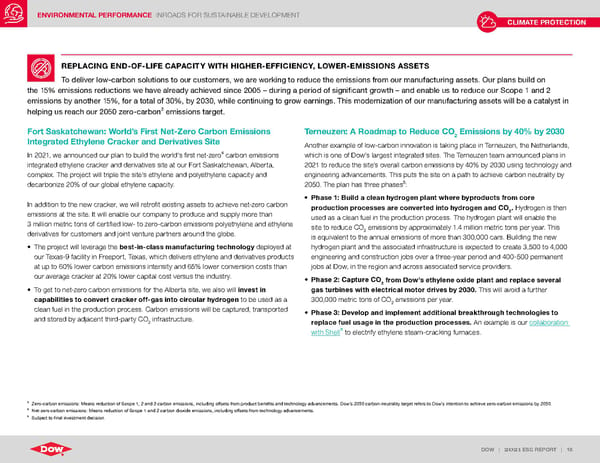ENVIRONMENTAL PERFORMANCE INROADS FOR SUSTAINABLE DEVELOPMENT DOW | 2021 ESG REPORT | 18 REPLACING END-OF-LIFE CAPACITY WITH HIGHER-EFFICIENCY, LOWER-EMISSIONS ASSETS To deliver low-carbon solutions to our customers, we are working to reduce the emissions from our manufacturing assets. Our plans build on the 15% emissions reductions we have already achieved since 2005 – during a period of significant growth – and enable us to reduce our Scope 1 and 2 emissions by another 15%, for a total of 30%, by 2030, while continuing to grow earnings. This modernization of our manufacturing assets will be a catalyst in helping us reach our 2050 zero-carbon 3 emissions target. Fort Saskatchewan: World’s First Net-Zero Carbon Emissions Integrated Ethylene Cracker and Derivatives Site In 2021, we announced our plan to build the world’s first net-zero 4 carbon emissions integrated ethylene cracker and derivatives site at our Fort Saskatchewan, Alberta, complex. The project will triple the site’s ethylene and polyethylene capacity and decarbonize 20% of our global ethylene capacity. In addition to the new cracker, we will retrofit existing assets to achieve net-zero carbon emissions at the site. It will enable our company to produce and supply more than 3 million metric tons of certified low- to zero-carbon emissions polyethylene and ethylene derivatives for customers and joint venture partners around the globe. • The project will leverage the best-in-class manufacturing technology deployed at our Texas-9 facility in Freeport, Texas, which delivers ethylene and derivatives products at up to 60% lower carbon emissions intensity and 65% lower conversion costs than our average cracker at 20% lower capital cost versus the industry. • To get to net-zero carbon emissions for the Alberta site, we also will invest in capabilities to convert cracker off-gas into circular hydrogen to be used as a clean fuel in the production process. Carbon emissions will be captured, transported and stored by adjacent third-party CO 2 infrastructure. Terneuzen: A Roadmap to Reduce CO 2 Emissions by 40% by 2030 Another example of low-carbon innovation is taking place in Terneuzen, the Netherlands, which is one of Dow’s largest integrated sites. The Terneuzen team announced plans in 2021 to reduce the site’s overall carbon emissions by 40% by 2030 using technology and engineering advancements. This puts the site on a path to achieve carbon neutrality by 2050. The plan has three phases 5 : • Phase 1: Build a clean hydrogen plant where byproducts from core production processes are converted into hydrogen and CO 2 . Hydrogen is then used as a clean fuel in the production process. The hydrogen plant will enable the site to reduce CO 2 emissions by approximately 1.4 million metric tons per year. This is equivalent to the annual emissions of more than 300,000 cars. Building the new hydrogen plant and the associated infrastructure is expected to create 3,500 to 4,000 engineering and construction jobs over a three-year period and 400-500 permanent jobs at Dow, in the region and across associated service providers. • Phase 2: Capture CO 2 from Dow’s ethylene oxide plant and replace several gas turbines with electrical motor drives by 2030. This will avoid a further 300,000 metric tons of CO 2 emissions per year. • Phase 3: Develop and implement additional breakthrough technologies to replace fuel usage in the production processes. An example is our collaboration with Shell to electrify ethylene steam-cracking furnaces. CLIMATE PROTECTION 3 Zero-carbon emissions: Means reduction of Scope 1, 2 and 3 carbon emissions, including offsets from product benefits and technology advancements. Dow’s 2050 carbon-neutrality target refers to Dow’s intention to achieve zero-carbon emissions by 2050. 4 Net-zero carbon emissions: Means reduction of Scope 1 and 2 carbon dioxide emissions, including offsets from technology advancements. 5 Subject to final investment decision.
 ESG Report | Dow Page 17 Page 19
ESG Report | Dow Page 17 Page 19